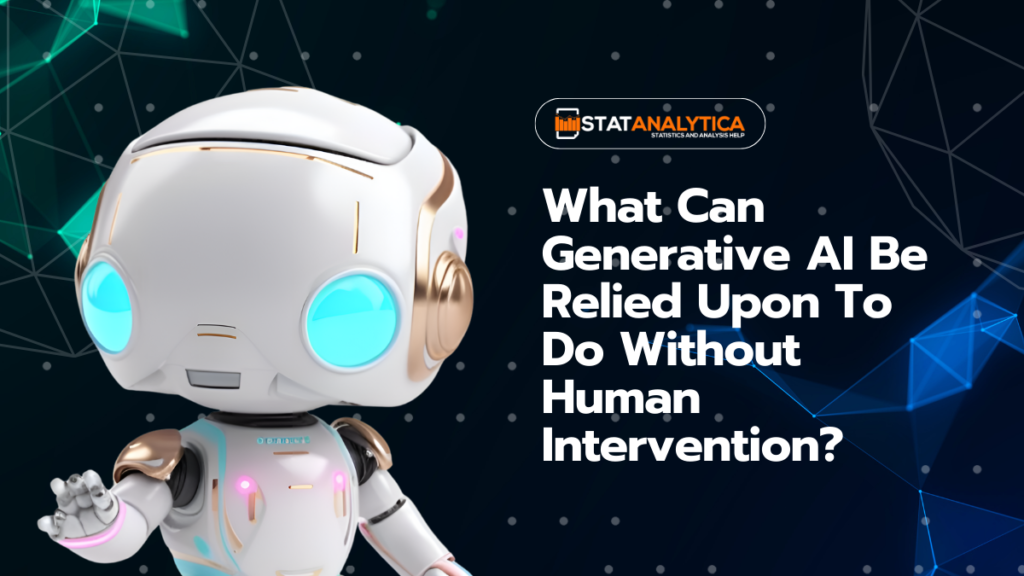Generative AI is a fascinating technology that has the potential to change our world in many ways. But what exactly can it do on its own, without any help from humans? In this blog, we’ll explore this question in simple terms, perfect for students to understand. We’ll look at different areas of what can generative AI be relied upon to do without human intervention, and provide examples to make things clear.

What is Generative AI?
Table of Contents
Before diving into what generative AI can do, let’s quickly understand what it is. Generative AI refers to technology that can produce new content, like text, images, music, and videos. These systems learn from existing data and use that information to create fresh, original works.
What Can Generative AI Be Relied Upon To Do Without Human Intervention?
Creating Text
One of the most impressive abilities of generative AI is its capacity to create text. AI models like GPT-4, the one powering this blog, can write essays, stories, news articles, and more.
Writing Stories and Essays
Generative AI can write stories and essays without human intervention. For instance, if you give an AI a prompt like “Write a story about a hero who saves a village,” it can create a complete and coherent story based on that prompt. Here’s a brief example:
Example
Once upon a time, in a small village nestled between mountains, a young hero named Aria discovered a hidden cave. Inside, she found an ancient sword with magical powers.
When a fierce dragon threatened her village, Aria bravely confronted it with her new weapon. After a fierce battle, she emerged victorious, saving her village from destruction.
Generating News Articles
AI can also generate news articles by analyzing current events and creating a summary or a full article. For example, if an AI is fed data about a recent sports event, it can write an article summarizing the key highlights of the game.
Example
In an exciting match last night, the Warriors defeated the Lakers with a final score of 102-98. Star player James scored 30 points, leading his team to victory.
Creating Images
Generative AI is also capable of creating images. AI models can generate realistic photos, drawings, and even art pieces from scratch.
Creating Realistic Photos
AI can generate realistic photos of people, places, and objects that don’t exist in real life. For example, it can create a photo of a person who looks completely real but is actually entirely made up by the AI.
Example
Imagine a new fashion magazine needing models for its cover. Instead of hiring a photographer and models, they can use AI to create images of models wearing the latest fashion trends.
Artistic Creations
AI can also be used to create original pieces of art. Artists and designers are starting to use AI tools to come up with new and unique designs.
Example
An AI art generator can create a painting in the style of Van Gogh. By analyzing Van Gogh’s works, the AI can generate new pieces that look like they were painted by the famous artist himself.
Making Music
Generative AI can also compose music. It can create new melodies, harmonies, and even complete songs.
Composing New Music
Musicians can use AI to compose new pieces of music. For instance, if you give an AI a genre and a few notes to start with, it can generate a whole song.
Example
A musician inputs a few chords and a melody into an AI music generator. The AI then creates a full-length song based on those inputs, complete with verses, chorus, and instrumental sections.
Remixing Existing Music
AI can take existing songs and create new remixes. By analyzing the structure and components of a song, it can generate a new version with a different style or tempo.
Example
An AI remixes a pop song into a jazz version, changing the rhythm and adding jazz instruments like saxophones and pianos.
Creating Videos
Generative AI can also create videos, including animations and deepfake videos.
Animations
AI can generate animations from scratch. This includes creating characters, backgrounds, and the movement of characters.
Example
An AI animation tool can create a short cartoon based on a written script. It designs the characters, animates their movements, and even adds voices and sound effects.
Deepfake Videos
Deepfake technology uses AI to create realistic videos where someone appears to say or do something they never actually did. While this technology has controversial uses, it also has potential in entertainment and film production.
Example
An AI deepfake tool can create a video where a historical figure, like Abraham Lincoln, gives a modern-day speech.
Automating Customer Service
Generative AI is increasingly used in customer service to handle inquiries and provide assistance without human intervention.
Chatbots
AI-powered chatbots can interact with customers, answer questions, and provide support.
Example
When you visit a website and a chat window pops up asking if you need help, that’s often an AI chatbot. It can answer common questions, help you find products, and even process orders.
Virtual Assistants
Virtual assistants
Example
You can ask Alexa to play your favorite song, set a reminder, or tell you the weather forecast. The AI processes your request and provides the appropriate response.
Data Analysis and Predictions
Generative AI is also used in data analysis to make predictions and provide insights.
Analyzing Trends
AI can analyze large datasets to identify trends and patterns. This is useful in fields like finance, marketing, and healthcare.
Example
A retail company uses AI to analyze sales data from the past year. The AI identifies which products are most popular during different seasons and predicts future sales trends.
Predictive Maintenance
In industries like manufacturing, AI can predict when machines are likely to fail, allowing for preventive maintenance.
Example
An AI system monitors factory equipment and predicts when a machine is likely to break down. This helps the company fix things before they break, cutting down on downtime and expenses.
Improving Accessibility
Generative AI can create tools that improve accessibility for people with disabilities.
Text-to-Speech
AI can convert written text into spoken words, helping visually impaired individuals.
Example
A visually impaired student uses an AI-powered app to read their textbooks aloud, allowing them to listen to the content instead of reading it.
Speech-to-Text
AI can also convert spoken words into written text, assisting those with hearing impairments.
Example
During a lecture, an AI tool transcribes the teacher’s speech in real-time, displaying the text on a screen for hearing-impaired students.
Personalizing Content
Generative AI can personalize content to fit individual preferences and needs.
Personalized Recommendations
AI can recommend products, movies, music, and more based on a user’s past behavior.
Example
Netflix uses AI to suggest movies and TV shows based on what you’ve watched before. If you enjoyed a particular action movie, the AI might recommend similar action films.
Customizing Learning Experiences
In education, AI can create personalized learning plans for students based on their strengths and weaknesses.
Example
An online learning platform uses AI to analyze a student’s performance on quizzes and assignments. It then recommends specific lessons and practice exercises to help the student improve in areas where they struggle.
What Are The Ethical Considerations?
While generative AI can do many amazing things independently, it also raises important ethical questions. It’s crucial to consider the potential impacts and ensure AI is used responsibly.
- Bias and Fairness
AI systems can sometimes be biased if they learn from biased data. It’s important to ensure that AI is fair and unbiased.
- Example: If an AI is trained on job application data that includes biases against certain groups, it might unfairly favor or disfavor applicants based on those biases. Developers need to check and correct these biases.
- Privacy Concerns
AI systems often require a lot of data, raising concerns about privacy and data security.
- Example: A generative AI system that personalizes recommendations might need access to a lot of personal data. It’s important to ensure this data is handled securely and with respect for users’ privacy.
Conclusion
What can generative AI be relied upon to do without human intervention? Generative AI is a strong tool that can do many tasks on its own, like making text, images, and music, helping with customer service, and analyzing data. It has the potential to make our lives much better in many ways.
However, we must use this technology carefully, keeping in mind ethical issues and making sure it is fair and respects privacy. As AI develops, it will be able to do even more without human help, leading to more innovation and creativity.


